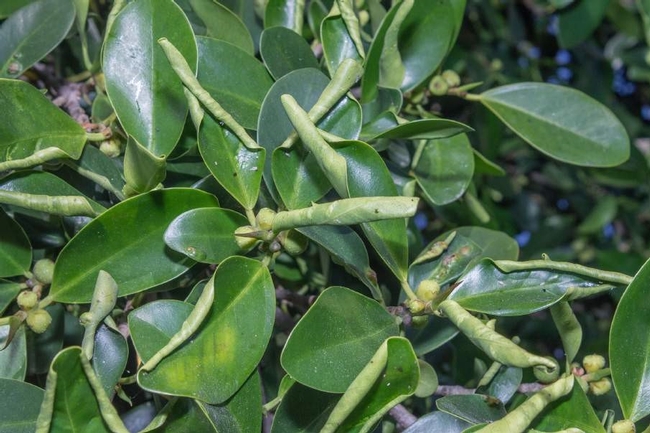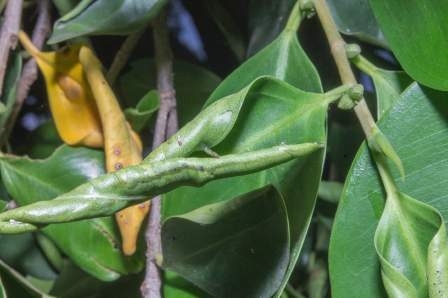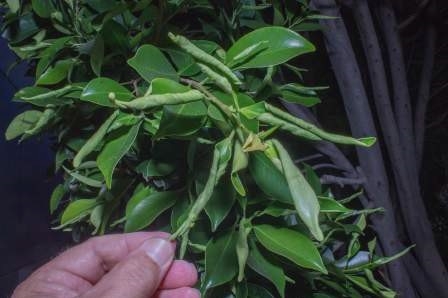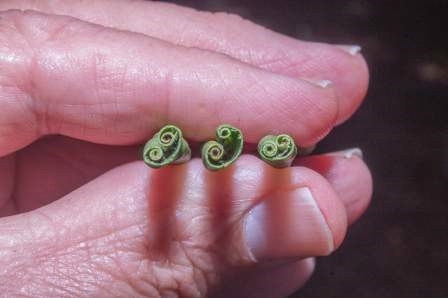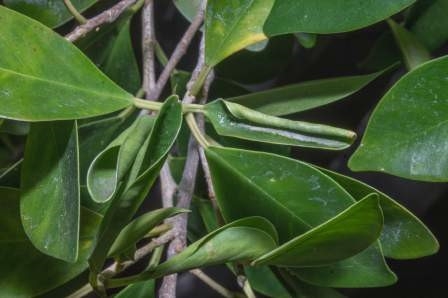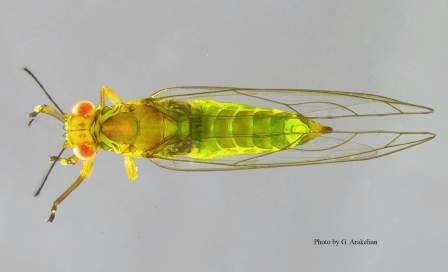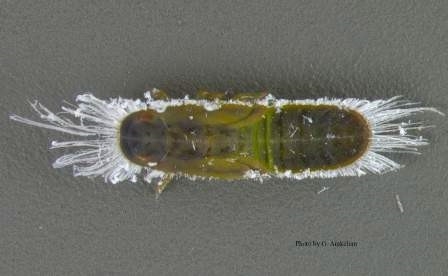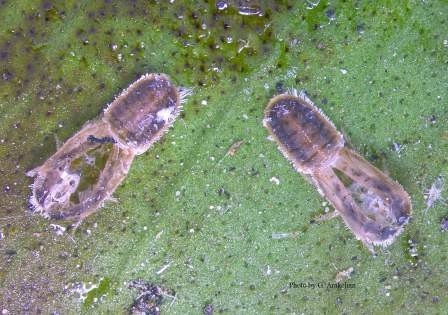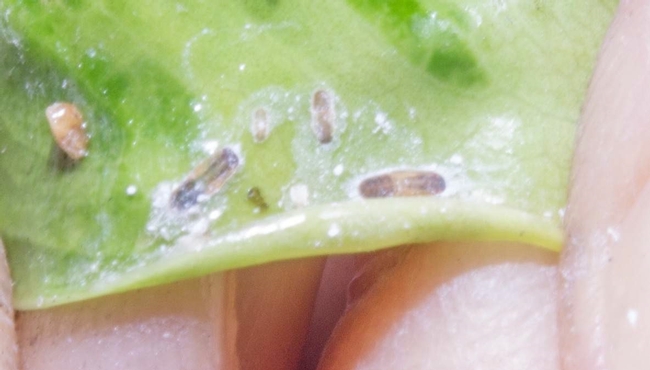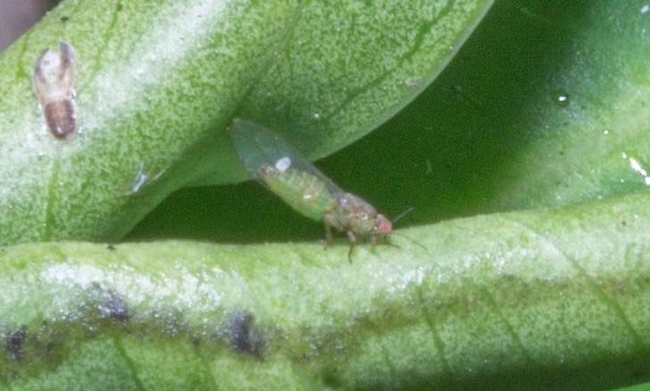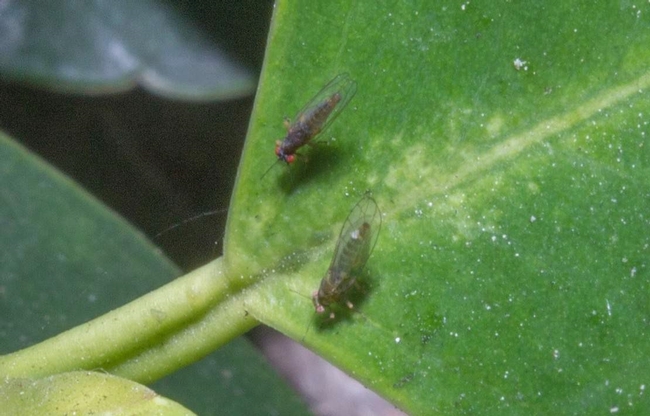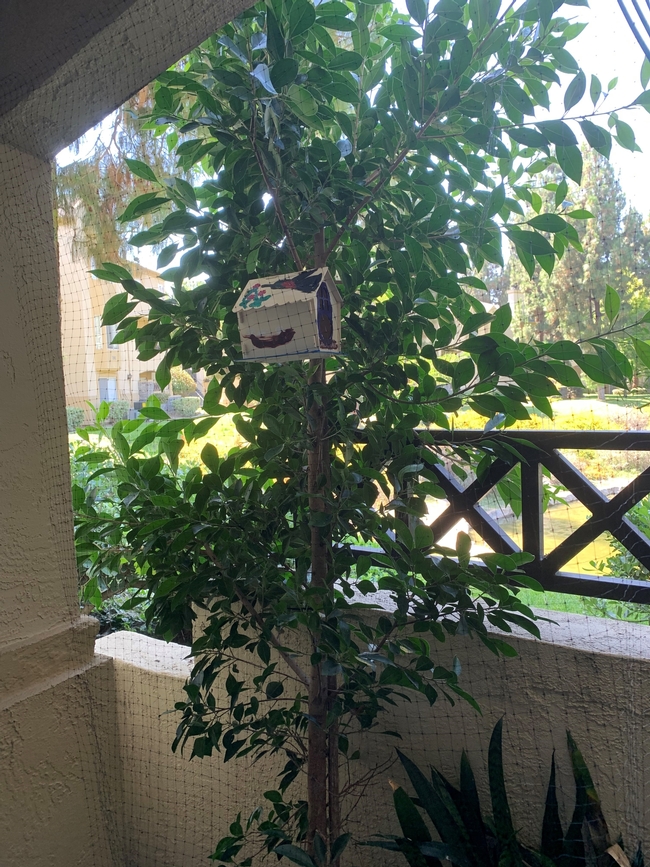What's new in Landscape and Urban Hort?
New Law Requires Annual Training for Anyone Applying Pesticides at School Sites
[From the December 2016 issue of the UC IPM Green Bulletin] School is already back in session for many children in districts throughout California, and several others will be starting back to school in the next couple of weeks. While students and...
Two New HLB Diseased Trees Found in Los Angeles
August 11, 2016 Two more trees have been confirmed positive for Huanglongbing (HLB), the plant disease carried by an invasive insect called the Asian citrus psyllid (ACP). One tree is located in San Gabriel and the other is in Hacienda Heights, in very...
Ficus leaf-rolling psyllid, Trioza brevigenae: a new pest of Ficus microcarpa in southern California
Ficus microcarpa, a common ornamental landscape tree (top). Leaf rolling by the ficus leaf-rolling psyllid, Trioza brevigenae (bottom). (Photos by Donald R. Hodel, UCCE)
A psyllid, perhaps new to the Western Hemisphere, has been found on Ficus microcarpa (Chinese banyan, Indian laurel fig) in Los Angeles, Orange, San Bernardino, Ventura, San Diego, and Riverside counties. It causes a distinctive, tight, and typically complete rolling of the leaves. Ficus microcarpa is one of the most common, useful, and widespread ornamental landscape trees, and has long been a target for numerous pests.
Alessandra Rung, an entomologist and thrips specialist at the California Department of Food and Agriculture, with the help of Daniel Burckhard, a psyllid specialist at the Natural History Museum of Basel, Switzerland identified the psyllid as Trioza brevigenae Mathur. This psyllid does not have a common name and we refer to it as the ficus leaf-rolling psyllid (FLRP). FLRP belongs to the family Triozidae in the order Hemiptera. Triozids are commonly known as tip sheet fleas and along with the members of seven other closely related families, they are also referred to as jumping plant-lice, which is a psynonym for psyllids (Burckhardt and Ouvrard, 2012).
Origin and distribution
FLRP was first detected by coauthor, Linda Ohara on trees in Carson south of Los Angeles in February, 2016 during a routine survey of pests on F. microcarpa (sometimes erroneously referred to as F. nitida or F. retusa)and later observed in several areas including western Los Angeles, Pasadena, Duarte, LongBeach, Lakewood, Claremont, and Universal City (San Fernando Valley) in Los Angeles County; Irvine and Anaheim in Orange County; Thousand Oaks in eastern Ventura County; Oceanside in northern San Diego County; Montclair in western San Bernardino County; and Corona in western Riverside County. It is likely widespread, perhaps even outside this six-county area.
FLRP is native to India and is not reported from anywhere else in the world (Hodkinson, 1986; Ouvrard, 2013). It is one of the 22 Trioza spp. in India (Yang and Raman, 2007; Ouvrard, 2013). It is not clear how it arrived into the US, but the infestation appears to be a recent one as damage was not observed during a previous survey in January, 2016.
Damage
Leaf rolling starts at the tip of the leaf blade and eventually ends as tight rolls (Photos by Donald R. Hodel, UCCE)
FLRP causes a distinctive leaf-rolling of newly developing leaves are tightly rolled into a narrow cylinder, compressed to a diameter of 3-5 mm as they mature. Leaf rolling is conspicuous on heavily infested trees. Rolling appears to begin at the distal end or apex of the leaf and progresses adaxially along each margin towards the leaf base. In some cases, only one margin rolls and stops at the midrib of the leaf. Damage leaves are brittle, but remain green when only FLRP is present. Other pests such as mealybugs and the leaf gall wasp, Josephiella microcarpae might also be present in the rolled leaves and cause discoloration or further deformation. The tight leaf rolling of FLRP is distinct from the loose curling or folding from the Cuban laurel thrips, Gynaikothrips ficorum or the folded-leaf galls caused by the weeping fig thrips, G. uzeli, which also cause reddish scars on the damaged leaves (Dara and Hodel, 2015). Spiders and other insects may also cause loose leaf rolling that can be easily distinguished from FLRP damage.
Leaf rolling and folding by spiders, which is different from the tight rolling by FLRP (Photo by Donald R. Hodel, UCCE)
Information on the severity or the extent of damage caused by FLRP is not clear, but under severe infestations excessive leaf rolling could affect photosynthesis and thus the plant health. As seen in some specimens, leaf rolls might also harbor secondary pests.
Biology
Information on the biology of FLRP is lacking in scientific literature. Adults are 2.6-2.8 mm long with brownish green head and thorax, and protruding red eyes. Abdomen is green in young adults and turns brown with maturity. Wings are 3 mm long, transparent with no color pattern, and extend beyond the posterior end of the abdomen. Females are larger than males. Adults are typically found outside and adjacent to the rolled leaves. Nymphs are mobile, 1-2.5 mm long, and oblong with dark greyish tan bodies that turn brownish or brownish green with age. Advanced nymphal instars have skirts of long, white, waxy filaments at cranial and caudal parts of their bodies. Wingpads are also visible in latter instars and are extended anteriorly close to the eye level. Eggs were not found during the observations.
Adult FLRP with protruding reddish eyes, green abdomen, and transparent wings (above). Mature nymph with white, waxy filaments (below). (Photo by Gevork Arakelian, Los Angeles County)
Emergence of the adult FLRP (above). Cast skins after the adult emergence (below). (Photos by Gevork Arakelian, Los Angeles County)
Nymphal instars at different stages of development (above) and a mature nymph and adult FLRP (below). (Photos by Donald R. Hodel, UCCE)
Adult FLRP with their typical posture of raised abdomens (Photo by Donald R. Hodel, UCCE)
Like many psyllid species, FLRP aligns its body at a 45 degree angle to the leaf surface with a raised abdomen. It moves the abdomen sideways like a dog wagging its tail. In a peculiar behavior that FLRP exhibited, adults extended the wings until they are at a right angle to the body and then waved them back and forth.
Being a tropical pest, FLRP was more detectable during warmer (25-30oC or 76-86oF or more) and still weather than during cooler, cloudy, and breezy weather conditions.
Management
No information is currently available about the management of FLRP. Leaf-rolls are likely to protect the immature stages from contact insecticides and possibly from some common natural enemies. Although wings, lady beetles, and minute pirate bugs were found on the foliage of the infested trees, their role as potential biocontrol agents is not clear. Initial observations indicated that infestations were higher on trees with younger leaves. Since FLRP appears to have a tendency to infest newly emerging leaves, careful scouting and removal (and bagging) of the infested leaves can help reduce the spread of infestations. Depending on the level of infestation and life stages of the pest, contact insecticides for adults and systemic insecticides against immature stages can be considered. Ficus microcarpa cultivars Green Gem and Variegata, which are resistant to some pests, does not seem to resist FLRP.
Input from a client:
"We successfully controlled a severe outbreak of FLRP on our potted Ficus microcarpa in Chula Vista CA. I first noticed the rolled leaves in late July. Within 10 days many of the leaves on the ends of all of the branches showed FLRP. I treated with granular imidacloprid (.55%)+clothianidin per directions and watered in. This control worked slowly at first. For 21 days we still saw FLRP in ever reducing numbers. I retreated every 10 days. We also used Neem oil on the entire plant in late August, and spot treatment on Sept. 3. We now have complete control. No curled leaves have been seen since September 4. This method has of control worked for us." David Pearling, trained horticulture expert
If you see FLRP infestations contact your local UCCE or Ag Commissioner's office. You may also contact me at 805-720-1700 or skdara@ucdavis.edu to help me track the distribution of the pest.
This article was based on the original article by Hodel et al. (2016) published in the e-journal, PalmArbor (http://ucanr.edu/sites/HodelPalmsTrees/files/242336.pdf).
http://ucanr.edu/articlefeedback
References
Burckhardt, D. and Ouvrard, D. 2012. A revised classification of the jumping plant-lice (Hemiptera: Psylloidea). Zootaxa 3509: 1-34. http://www.imok.ufl.edu/hlb/database/pdf/00003080.pdf
Dara, S. K. and Hodel, D. R. 2015. Weeping fig thrips (Thysanoptera: Phlaeothripidae) in California and a review of its biology and management options. J. Integ. Pest Mngmt. 6: 2; DOI: 10.1093/jipm/pmv001.
Hodkinson, I. D. 1986. The psyllids (Homoptera: Psylloidea) of the Oriental Zoogeographical Region: an annotated check-list. J. Nat. Hstory 20: 299-357.
Hodel, D. R., Arakelian, G., Ohara, L. M., Wilen, C. and Dara, S. K. 2016. The ficus leaf-rolling psyllid: a new pest of Ficus microcarpa. PalmArbor 2: 1-9.
Ouvrard, D. 2013. Psyl'list- The world Psylloidea database. http://www.hemiptera-databases.com/psyllist
Yang, M.-M. and Raman, A. 2007. Diversity, richness, and patterns of radiation among gall-inducing psyllids (Hemiptera: Psylloidea) in the orient and Eastern Palearctic. Oriental Insects 41: 55-65.
Authors
Donald R. Hodel, Landscape Horticulture Advisor, University of California Cooperative Extension, Los Angeles.
Gevork Arakelian, Entomologist, Los Angeles County Agricultural Commissioner/ Weights & Measures in South Gate, CA.
Linda M. Ohara, Biological Science Lab Technician, El Camino College in Torrance, CA, a horticulturist, and a former nurserywoman.
Surendra K. Dara, Strawberry and Vegetable Crops Advisor, University of California Cooperative Extension.
Cheryl Wilen, Area IPM Advisor, University of California Cooperative Extension, San Diego, CA.
Don't Be Alarmed by Large Beneficial Bees
If you see large black or golden-brown bees flying in your garden or landscape, don't be alarmed! These insects are most likely carpenter bees, and although their large size and loud buzzing can be intimidating, they are mostly harmless. Males can't...
Top 4 Videos for Summer Nuisance Pests!
Every summer, a handful of insect pests can become a real nuisance when they invade your space, bite, or sting you. Whether you take a staycation or a vacation, you'll want to watch our videos for tips on how to deal with these pests when you encounter...


